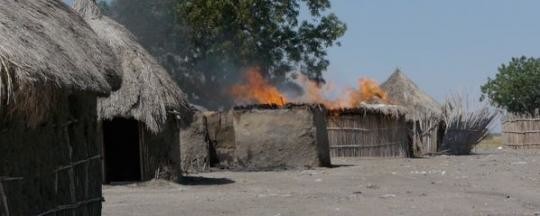Four months into the conflict in South Sudan, fresh fighting erupted this week after a lull of some weeks, prompting more warnings of a possible famine owing to the disruption of economic activity and massive displacement of about a tenth of the population. Here five reasons are given for why fighting is continuing in South Sudan.
1. Treason trial: The continuing prosecution of four political prisoners for treason, including the ousted secretary-general of the ruling party SPLM, is the primary justification cited by the opposition for prolonging the war.
For the rebels, their release was considered a necessary condition for the ceasefire agreement itself, which was why the mediation ensured the signing of the Agreement on the Status of Detainees concurrently with the Agreement on Cessation of Hostilities, both on 23 January.
All four detainees are from greater Upper Nile, the region most affected by violence. Two are Shilluk, one Nuer and one Dinka; one is from Jonglei and three are from Upper Nile State.
From the moment the four detainees stepped into the dock, the chances for progress toward political resolution of the conflict were dramatically reduced. The trial is set to resume Thursday following testimony by the ex-deputy defense minister Tuesday.
2. Leadership choices: In the end, the continuation of the war is largely a choice of political leaders on both sides. For a long time, all indications have pointed to the fact that the leadership on both sides actually want to continue the fight.
Recent interviews given by the ousted vice president Riek Machar reveal that he never ordered his commanders to stand down, even after signing a ceasefire agreement, but rather encouraged them to attack Malakal and oil fields held by the government.
On the other side, the government likewise stands accused by the IGAD mediation of ‘flagrant violations’ of the ceasefire, and it has continued its recruitment drive in order to bring more troops to the front.
3. Ethnicization of the conflict: South Sudanese officials generally have argued that the conflict is not at root an ethnic one, but nonetheless tend to point out that the opposition leader Riek Machar has resorted to racial incitement to mobilize followers from his Nuer tribe.
The reverse is true, say Machar’s adherents, claiming that the government is ‘genocidal’ and mobilizing troops primarily only from a base of support among President Kiir’s Dinka tribe.
Regardless of who is right, these mutual recriminations have increased pressures on moderates, such as Nuer loyalists in the SPLA, and non-involved persons on both sides of the ethnic divide.
Both sides have begun to resort to arming of local youth and tribal militia in various areas of their control, such as eastern Warrap, where Dinka youths have been tasked by the governor with defense of the region, or in eastern Upper Nile, where Machar’s commanders mobilized Nuer youths for operations against Malakal and the oil fields.
Although open racial incitement is limited in the political arena, subtler signals of the growing breach are clearly in evidence, and there can be no doubt that such incitement is an easier recourse in the field.
A recent bout of fighting between communities along the frontier between Unity and neighboring Warrap and Lakes states is but one example of the direction in which this trend could possibly lead.
4. Impunity for war crimes: Months of bloodshed have emboldened fighters and commanders responsible for war crimes, including instances of civilian massacres, executions, rapes, torture, pillaging and burning of towns and villages.
Starting in Juba from 15-18 December, when hundreds of men were massacred and buried in mass graves, reports of atrocities have continued to emerge, such as the killings of patients and refuge-seekers at churches and hospitals in key towns Malakal, Bor and Bentiu.
These, however, are only the most widely reported incidents, with the number of unreported or underreported crimes perpetrated in remote villages and battlefields likely in the hundreds if not thousands.
In most cases there appears to be no possibility of any redress to justice for victims or their families, and no possibility of punishment of perpetrators. The total collapse of rule of law – not only in the three main conflict states, but increasingly in other areas as well – paired with a warrior culture of bloodletting and revenge-seeking, increasingly has turned fighters into murderers with their own strong motives for perpetuating violence and discouraging any return of peace and justice.
5. Lack of solutions in view: There are very few credible, unifying political ideas in circulation in South Sudan. State-building ideas pushed hard by the UN and international donors failed to gain the backing of the political class, let alone the populace, who still view the state with distrust. The ruling party SPLM’s structure and programme are in disarray. The constitution-making process for a permanent constitution never got off the ground. The civil society is timid, disorganized and largely inactive.
And there is no deliberative culture and little political discourse even in the arenas where one might expect it, such as the state and national parliaments, or in the media.
The failure or obsolescence of key ideas, and the absence of processes by which fresh ideas could gain currency, has resulted in an environment of paralysis and fear. With every passing day, the governance crisis deepens and political solutions remain out of view.
In sum, the country is witnessing a period of intellectual exhaustion, in which many key actors – politicians, commanders, mediators, diplomats and bureaucrats – are either completely at a loss as to what to do, or proposing ideas and solutions that are no longer viable under the radically changed circumstances.
By Daniel van Oudenaren
Photo: A home burns in Malakal, South Sudan, on February 13, 2014 (Human Rights Watch)




